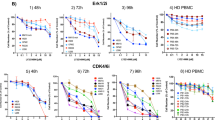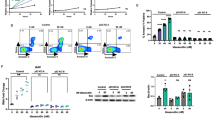Abstract
The t(4;14)(p16.3;q32), associated with 10–20% of cases of multiple myeloma (MM), deregulates the expression of MMSET and FGFR3. To assess the potential of FGFR3 as a drug target, we evaluated the effects of selective inhibitors on MM and control cell lines. SU5402 and PD173074 specifically inhibited the growth of the two t(4;14)-positive MM lines, KMS-11 and OPM-2. Importantly, inhibition was still observed in the presence of IL-6, a growth factor known to play an important role in MM. Both compounds induced a dose-dependent reduction in cell viability and an increase in apoptosis, accompanied by a decrease in extracellular signal-related kinase phosphorylation. In contrast, no inhibition was seen with either compound against t(4;14)-negative cell lines or NCI-H929, a t(4;14)-positive, FGFR3-negative MM cell line. FGFR3 is thus a plausible candidate for targeted therapy in a subset of MM patients.
This is a preview of subscription content, access via your institution
Access options
Subscribe to this journal
Receive 12 print issues and online access
$259.00 per year
only $21.58 per issue
Buy this article
- Purchase on Springer Link
- Instant access to full article PDF
Prices may be subject to local taxes which are calculated during checkout






Similar content being viewed by others
References
Chesi M, Nardin, E, Brents LA, Schrock E, Ried T, Kuehl WM et al. Frequent translocation t(4;14)(p16.3;q32.3) in multiple myeloma is associated with increased expression and activating mutations of fibroblast growth factor receptor 3. Nat Genet 1997; 16: 260–264.
Giri D, Ropiquet F, Ittmann M . Alterations in expression of basic fibroblast growth factor (FGF) 2 and its receptor FGFR-1 in human prostate cancer. Clin Cancer Res 199; 5: 1063–1071.
Onose H, Emoto N, Sugihara H, Shimizu K, Wakabayashi I . Overexpression of fibroblast growth factor receptor 3 in a human thyroid carcinoma cell line results in overgrowth of the confluent cultures. Eur J Endocrinol 1999; 140: 169–173.
Yoshimura N, Sano H, Hashiramoto A, Yamada R, Nakajima H, Kondo M et al. The expression and localization of fibroblast growth factor-1 (FGF-1) and FGF receptor-1 (FGFR1) in human breast cancer. Clin Immunol Immunopathol 1998; 89: 28–34.
Wagner M, Lopez ME, Cahn M, Korc M . Suppression of fibroblast growth factor receptor signalling inhibits pancreatic cancer growth in vitro and in vivo. Gastroenterology 1998; 114: 798–807.
Macdonald DHC, Reiter A, Cross NCP . The 8p11 myeloproliferative syndrome: a distinct clinical entity caused by constitutive activation of FGFR1. Acta Haematol 2002; 107: 101–107.
Yagasaki F, Wakao D, Yokoyama Y, Uchida Y, Murohashi I, Kayano H et al. Fusion of ETV6 to fibroblast growth factor receptor 3 in peripheral T-cell lymphoma with a t(4;12)(p16;p13) chromosomal translocation. Cancer Res 2001; 61: 8371–8374.
Cappellen D, De Oliveira C, Ricol D, de Medina S, Bourdin J, Sastre-Garau X et al. Frequent activating mutations of FGFR3 in human bladder and cervix carcinomas. Nat Genet 1999; 23: 18–20.
Chesi M, Brents LA, Ely SA, Bais C, Robbiani DF, Mesri EA et al. Activated fibroblast growth factor receptor 3 is an oncogene that contributes to tumor progression in multiple myeloma. Blood 2001; 97: 729–736.
Soverini S, Terragna C, Testoni N, Ruggeri D, Tosi P, Zamagni E et al. Novel mutation and RNA splice variant of fibroblast growth factor receptor 3 in multiple myeloma patients at diagnosis. Haematologica 2002; 87: 1036–1040.
Sibley K, Fenton JA, Dring AM, Ashcroft AJ, Rawstron AC, Morgan GJ . A molecular study of the t(4;14) in multiple myeloma. Br J Haematol 2002; 118: 514–520.
Plowright EE, Li Z, Bergsagel PL, Chesi M, Barber DL, Branch DR et al. Ectopic expression of fibroblast growth factor receptor 3 promotes myeloma cell proliferation and prevents apoptosis. Blood 2000; 95: 992–998.
Li Z, Zhu YX, Plowright EE, Bergsagel PL, Chesi M, Patterson B et al. The myeloma-associated oncogene fibroblast growth factor receptor 3 is transforming in hematopoietic cells. Blood 2001; 97: 2413–2419.
Smedley D, Demiroglu A, Abdul-Rauf M, Heath C, Cooper C, Shipley J et al. ZNF198-FGFR1 transforms Ba/F3 cells to growth factor independence and results in high level tyrosine phosphorylation of STATS 1 and 5. Neoplasia 1999; 1: 349–355.
Laird AD, Vajkoczy P, Shawver LK, Thurnher A, Liang C, Mohammadi M et al. SU6668 is a potent antiangiogenic and antitumor agent that induces regression of established tumors. Cancer Res 2000; 60: 4152–4160.
Mohammadi M, McMahon G, Sun L, Tang C, Hirth P, Yeh BK et al. Structures of the tyrosine kinase domain of fibroblast growth factor receptor in complex with inhibitors. Science 1997; 276: 955–960.
Skaper SD, Kee WJ, Facci L, Macdonald G, Doherty P, Walsh FS . The FGFR1 inhibitor PD 173074 selectively and potently antagonizes FGF-2 neurotrophic and neurotropic effects. J Neurochem 2000; 75: 1520–1527.
Demiroglu A, Steer EJ, Heath C, Taylor K, Bentley M, Allen SL et al. The t(8;22) in chronic myeloid leukaemia fuses BCR to FGFR1: transforming activity and specific inhibition of FGFR1 fusion proteins. Blood 2001; 98: 3778–3783.
Ronchetti D, Greco A, Compasso S, Colombo G, Dell’Era P, Otsuki T et al. Deregulated FGFR3 mutants in multiple myeloma cell lines with t(4;14): comparative analysis of Y373C, K650E and the novel G384D mutations. Oncogene 2001; 20: 3553–3562.
Santra M, Zhan F, Tian E, Barlogie B, Shaughnessy Jr J . A subset of multiple myeloma harboring the t(4;14)(p16;q32) translocation lacks FGFR3 expression but maintains an IGH/MMSET fusion transcript. Blood 2003; 101: 2374–2376.
Keats JJ, Reiman T, Maxwell CA, Taylor BJ, Larratt LM, Mant MJ et al. In multiple myeloma, t(4;14)(p16;q32) is an adverse prognostic factor irrespective of FGFR3 expression. Blood 2003; 101: 1520–1529.
Acknowledgements
This work was supported by the British Society of Haematology Research Trust and the Leukaemia Research Fund.
Author information
Authors and Affiliations
Corresponding author
Rights and permissions
About this article
Cite this article
Grand, E., Chase, A., Heath, C. et al. Targeting FGFR3 in multiple myeloma: inhibition of t(4;14)-positive cells by SU5402 and PD173074. Leukemia 18, 962–966 (2004). https://doi.org/10.1038/sj.leu.2403347
Received:
Accepted:
Published:
Issue Date:
DOI: https://doi.org/10.1038/sj.leu.2403347
Keywords
This article is cited by
-
The functional epigenetic landscape of aberrant gene expression in molecular subgroups of newly diagnosed multiple myeloma
Journal of Hematology & Oncology (2020)
-
NMR backbone assignments of the tyrosine kinase domain of human fibroblast growth factor receptor 3 in apo state and in complex with inhibitor PD173074
Biomolecular NMR Assignments (2018)
-
Neutralizing FGF4 protein in conditioned medium of IL-21-silenced HCT116 cells restores the migratory activity of the colorectal cancer cells
Cytotechnology (2018)
-
Self-patterning of rostral-caudal neuroectoderm requires dual role of Fgf signaling for localized Wnt antagonism
Nature Communications (2017)
-
The FGFR1 inhibitor PD173074 induces mesenchymal–epithelial transition through the transcription factor AP-1
British Journal of Cancer (2013)



